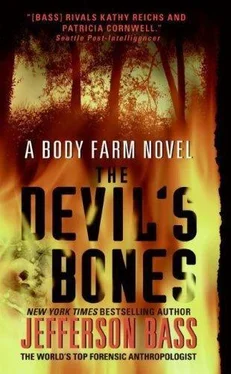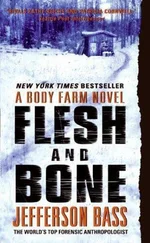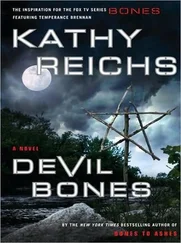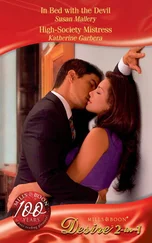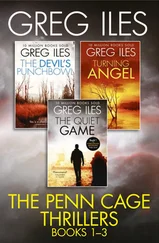Jefferson Bass - The Devil's Bones
Здесь есть возможность читать онлайн «Jefferson Bass - The Devil's Bones» весь текст электронной книги совершенно бесплатно (целиком полную версию без сокращений). В некоторых случаях можно слушать аудио, скачать через торрент в формате fb2 и присутствует краткое содержание. Год выпуска: 2009, Жанр: Детектив, на английском языке. Описание произведения, (предисловие) а так же отзывы посетителей доступны на портале библиотеки ЛибКат.
- Название:The Devil's Bones
- Автор:
- Жанр:
- Год:2009
- ISBN:нет данных
- Рейтинг книги:4 / 5. Голосов: 1
-
Избранное:Добавить в избранное
- Отзывы:
-
Ваша оценка:
- 80
- 1
- 2
- 3
- 4
- 5
The Devil's Bones: краткое содержание, описание и аннотация
Предлагаем к чтению аннотацию, описание, краткое содержание или предисловие (зависит от того, что написал сам автор книги «The Devil's Bones»). Если вы не нашли необходимую информацию о книге — напишите в комментариях, мы постараемся отыскать её.
The Devil's Bones — читать онлайн бесплатно полную книгу (весь текст) целиком
Ниже представлен текст книги, разбитый по страницам. Система сохранения места последней прочитанной страницы, позволяет с удобством читать онлайн бесплатно книгу «The Devil's Bones», без необходимости каждый раз заново искать на чём Вы остановились. Поставьте закладку, и сможете в любой момент перейти на страницу, на которой закончили чтение.
Интервал:
Закладка:
Still holding both skull fragments, I reached up to rub my eyes with the back of one hand. That’s when I saw it: a sliver of light glinting through one of the seams where Miranda had pieced together the larger of the two fragments. I angled the piece this way and that, studying the slight gap. Then I laid down the other piece so I could examine this one more closely. Swiveling around to the lab table behind me, I switched on the magnifying lamp and held the piece under the lens. The bone practically glowed beneath the built-in fluorescent light that encircled the lens. Magnified five times, the glue joints appeared wavy and jagged, almost like the sutures that form naturally in the skull as its individual plates knit together during childhood. The innermost of the skull’s three layers of bone, the diploe, had peeled away, exposing the boundary where the sinus cavity stopped and the spongy inner layer of bone began. If not for the peeling, Miranda and I would be forced to X-ray the reconstructed pieces to see the sinus boundary, rather than being able to see the cavity take shape as we worked.
Even under the magnifying glass, it was difficult to find the gap where I’d seen the light shining through. Twice I had to twist the head of the lamp upside down, shining it up toward my face, in order to send light through the tiny opening again; the second time I did this, I took a pencil and drew faint arrows on both the inner and outer surfaces of the bone so I could find the spot again easily. Having marked the location, I held the bone beneath the magnifier once more and leaned in for a close look. From the outside, the fit looked fine: From one piece to the next, the edges of bone transitioned almost perfectly across the glue joint. But from the inside-a spot that would have lain just beneath the left eyebrow-something didn’t exactly match up.
Rebuilding a shattered skull is a lot like rebuilding a Ming dynasty vase you’ve hurled into the fireplace in a fit of rage. The first few pieces fit together perfectly, zigs and zags and undulations mating exactly-partly because you’ve started with the biggest, easiest pieces, but also because it’s too soon for imperfection and distortion to rear their cumulative, misshapen heads. Gradually, though, minor imperfections start to compound, and the jig is up. Even if you tell yourself you can live with the cracks showing-they add a certain character and drama to the vase, after all, like tattoos and scars on skin-you know that the cemented shards will never again possess those elegant Ming lines. A missing crumb here or there distorts the fit by a thousandth of a degree; the china glue, though it be thin as water and only a few molecules thick, enlarges a reconstructed triangle just enough to keep it from nestling into its triangular niche. The edges and angles gradually cease to mate, forcing you into approximations and compromises-just as in the rest of life.
The piece of frontal bone I held in my hand had been patched together from seven irregular fragments, none as large as the nail of my little finger; glued together, the seven pieces were about the size of the fat end of a Grade-A Large egg. The chunk of bone fit within the palm of my hand-with an inch of palm showing all around it. Even so, even as small as it was, the multitude of irregular seams and angles and edges had begun to rebel against being forced back together. As I zeroed in on the edges marked by my penciled arrow, I could see that the fracture lines on one edge didn’t correspond exactly to those of the adjoining edge. What’s more, now that I was examining the fit with a dubious eye, I gradually became aware of a slight difference in the hue of the char on the bone’s outer surface. The difference was slight-so slight it tended to vanish if I looked at it directly, the way a faint star vanishes if you look at it directly-but whenever I glanced at it slantwise, rather than dead on, there it was, an elusive and skittish truth, crouching in the forensic underbrush: Miranda had glued the wrong piece here. I batted the magnifying lamp away; it spun around in a half circle on the end of its spring-loaded arm, then stopped and swayed in place. “Damn,” I said angrily, then “damn” again, this time softly and sadly. The angry damn was for the wasted time and misdirected effort, butting our heads against the wrong wall, in our efforts to compare a faulty reconstruction with an X-ray. The sad damn was for Miranda, who would doubtless be devastated to learn of her mistake.
I thought on that for a while. Did she actually need to learn of her mistake? Did she need to learn from her mistake? The teacher in me was inclined to think she did; otherwise she might make it again someday, in a case where there was no mentor looking over her shoulder to catch it and correct it. But another voice in me suggested that maybe I should cut her some slack, just this once-that I pushed too hard, expected too much, and held her to impossible standards; that the world wouldn’t end, and Miranda’s abilities wouldn’t self-destruct, if I didn’t point out this one small, understandable error. My inner teacher was winding up for a self-righteous retort-something to the effect that it would be condescending to protect Miranda from knowing she’d made a mistake-when my eye was caught by a glimmer in the tray of cranial fragments. The cascade of light from the magnifying lamp was now pooling in the tray of cranial fragments, and the lamp’s slight sway was causing a piece of bone to appear to move back and forth across the lens, growing and shrinking as it passed through the central field of view. It was almost as if the piece were breathing, expanding and contracting, coming to life. As I watched it, I realized that it looked familiar, in a backward sort of way, and then I realized why: Its jagged edge was the mirror image of one of the pieces in the reconstructed fragment. If I moistened the glue with just enough acetone-enough to detach Miranda’s mistake but not so much that all the pieces fell apart-I could substitute the piece that was dancing under the magnifying glass right now.
Ten minutes later the line of Duco cement was still damp where I’d plugged in the new piece of the puzzle. I left it drying on the light box-alongside the X-ray I’d just compared it to-and locked up the lab, springing into my truck. Threading out from beneath the stadium, I emerged into what I was surprised to find had become late-afternoon sunlight. I’d had my head buried in bone fragments for more than eight hours.
Hurrying west along Neyland Drive, I veered onto the northbound ramp of Alcoa Highway, the quickest way to I-40 east. As I merged onto the interstate, I checked the sun’s height in the rearview mirror. I estimated I had three hours of daylight left, maybe just two in the mountains. The drive would take one of those hours. I hoped the other would be enough time to find whatever it was that lay waiting for me in Cooke County.
CHAPTER 34
THE TRUCK’S REAR TIRES ISSUED A SERIES OF STEADYscreams as I careened around the curves of River Road. It was a good thing the day’s sun had already dried the pavement; otherwise I’d already be wrapped around one of the sycamores edging the riverbank.
The yellow line in the pavement fishtailed back and forth beneath the truck as I took every curve down the center or the inside-“straightening the curves,” southerners called it, and when I realized I was doing it, I laughed. I’d made my first foray into Cooke County less than a year before, and on that trip, on this very stretch of road, I had been a white-knuckled, dizzy-headed, carsick passenger. Now I was driving every bit as recklessly as that deputy sheriff had driven. Things change, I thought.
But not all things change, I realized. I felt a wave of nausea rising fast, and the beginnings of dizziness that warned me I was on the verge of triggering a bout of Ménière’s. Not now, I prayed, please not now. Sweat suddenly drenched my head, and my mouth flooded with saliva. I slowed the truck, turned the air-conditioning up to hurricane force, and started sucking in cold air for all I was worth.
Читать дальшеИнтервал:
Закладка:
Похожие книги на «The Devil's Bones»
Представляем Вашему вниманию похожие книги на «The Devil's Bones» списком для выбора. Мы отобрали схожую по названию и смыслу литературу в надежде предоставить читателям больше вариантов отыскать новые, интересные, ещё непрочитанные произведения.
Обсуждение, отзывы о книге «The Devil's Bones» и просто собственные мнения читателей. Оставьте ваши комментарии, напишите, что Вы думаете о произведении, его смысле или главных героях. Укажите что конкретно понравилось, а что нет, и почему Вы так считаете.
